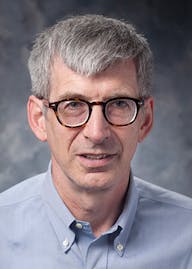
Kevin K McCully
- Professor Emeritus
Department of Kinesiology - Director
Exercise Muscle Physiology Laboratory
Biography
Areas of Expertise
- near infrared spectroscopy
- magnetic resonance spectroscopy
- doppler ultrasound
- muscle electrical stimulation
- localized muscle training
- skeletal muscle physiology
Interests
- skeletal muscle metabolism
- noninvasive technologies to study metabolism and blood flow
- cardiovascular disease
- disability health
- neuromuscular diseases
Concentrations
Education
- Ph.D. in Physiology, 1985
University of Michigan
Contact
Research Summary
The Exercise Muscle Physiology Laboratory is equipped to study skeletal muscle metabolism and oxygen delivery. Research is focused on developing new non-invasive approaches to studying skeletal muscle metabolism, blood flow and oxygen utilization. The lab focusing on changes to muscle function after chronic illnesses and injuries: including spinal cord injury, ALS, multiple sclerosis, cystic fibrosis, peripheral vascular disease and heart failure. The lab is also focused on innovative methods of improving physical activity levels and exercising people with chronic illnesses and injuries.
We use near infrared spectroscopy, Doppler Ultrasound, muscle accelerometry, electrical stimulation, MRI and 31P MRS to study humans. We also work on novel methods of training humans to improve health, primarily by training skeletal muscle.
IF YOU ARE A GRADUATE STUDENT INTERESTED IN OUR LAB, PLEASE CONTACT ME WHEN YOU SUBMIT YOUR APPLICATION TO OUR DEPARTMENT. YOU SHOULD ALSO CONSIDER VISITING OUR LAB SO THAT WE CAN LEARN MORE ABOUT YOU AND YOU CAN LEARN MORE ABOUT US.
Grants
MULTIPLE SCLEROSIS EXERCISE RESEARCH STUDY
The purpose of this study is to see what kinds of exercise people with MS prefer and do they benefit equally from in person or remote exercise training. This study is active at six sites around the country, including Athens Georgia. We are still recruiting for this study
If you are between the ages of 18 and 65 years and you have Multiple Sclerosis you may qualify if you: Can walk but with difficulty Do not exercise regularly Have been without a relapse in the past month Can commit to train 2 times a week for 16 weeks
Contact: Abisola Akinbobola at Abisola.Akinbobola@uga.edu or Kevin McCully at mccully@uga.edu (706-248-7316 )
Publications
- Sumner, M.D., S. Beard, E.K. Pryor, I. Das, K.K. McCully
- Frontiers of Physiology
Awards and Accolades
Western Michigan University
Western Michigan University, 1975
University of Western Ontario, 2003
National Academy of Kinesiology, 2007
South East American College of Sports Medicine, 2009
Athens Inclusive Recreation and Sports, 2013
South East American College of Sports Medicine, 2015
CURO UGA, 2017